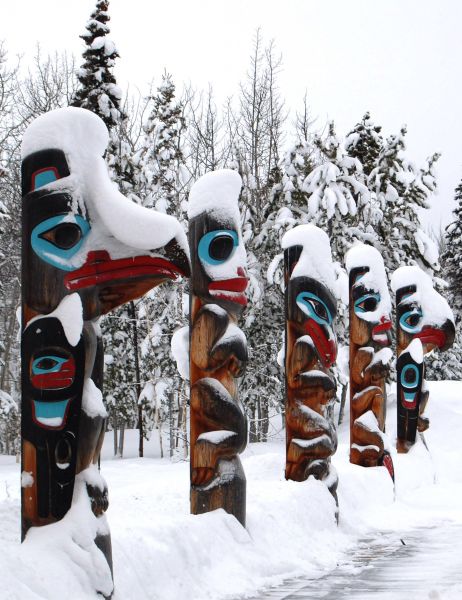About Us
Tlingit Translation

Tlingit Translation

Teslin Tlingit Council (TTC) is a self-governing First Nation based in Teslin in Southern Yukon Territory. Teslin Tlingit people have shared ancestry with the coastal Tlingit people of Southeast Alaska and the Inland Tlingit people of Taku River First Nation and Carcross/Tagish First Nation. The Village of Teslin is set on the confluence of Nisutlin Bay and Teslin Lake, located 183 kilometres east of Whitehorse on the Alaska Highway. The name Teslin is derived from the Inland Tlingit word tás ten, or "long sewing sinew”, which refers to the 148 kilometre long and narrow Teslin Lake flowing from British Columbia into southeast Yukon.
Teslin is located within Teslin Tlingit Traditional Territory and was a meeting place for Inland Tlingit people in the summer months. With the construction of the Alaska Highway in 1942, Teslin became a permanent settlement. Today, Teslin is an incorporated municipality within Yukon Territory and houses the majority of Teslin Tlingit Council’s government offices. For information about the current population and facilities of Teslin, visit the Village of Teslin website.
There are five Teslin Tlingit Clans, which play a central role in TTC’s government structure. The TTC consists of Departments that provide programs and services to TTC Citizens.
The five Clans are:
Clan membership is based on traditional practices and each Clan determines its membership.
Our People
Teslin Tlingit people are Inland Tlingit, who journeyed from the coast of southeast Alaska to the interior plains of the Yukon in the early 18th Century. Until the formation of permanent settlements with the construction of the Alaska Highway in 1942, Teslin Tlingit people practiced a semi-nomadic life and subsisted on fishing, hunting, and gathering. Fishing, hunting and gathering continue to play a large role in Teslin Tlingit culture, and today Elders pass on traditional knowledge to Tlingit youth through harvest camps.
Teslin Tlingit Council (TTC) Citizenship is based on blood lineage and traditional custom. At present, there are approximately 800 Citizens, around three hundred (300) live in the Village of Teslin, three hundred (300) in Whitehorse and throughout the Yukon, and two hundred (200) live elsewhere in North America. For information on citizenship Registration, visit our Citizenship page.
Our Tlingit Language
The Tlingit language is distantly related to Eyak, an extinct language from the Alaskan coast. Today, Tlingit is spoken in the Yukon communities of Teslin and Carcross, in the Atlin area of British Columbia, and in coastal settlements stretching along the Alaskan panhandle from Yakutat to Ketchikan. Given the geographic range of the language, there is relatively little dialect diversity and all speakers can generally understand each other.
Our History
Oral tradition is a precious source of Teslin Tlingit knowledge, and suggests the presence of Tlingit people in the Yukon further back in time than written history. It is the stories told by our Elders that provide knowledge of Inland Tlingit history and tradition.
The Journey from the Coast
The Teslin Tlingit people are descendants of the T’aakú Ḵwáan who, in the early 18th Century, moved from the coastal region of Southeast Alaska and settled inland along the shores of the salmon-rich upper Taku River. Here, they started a way of life separate from that of their coastal relatives. By the mid-19th century, the T’aakú Ḵwáan gradually expanded their contacts with the people who lived on the Yukon plateau while maintaining their social and economic ties with the coast. Trading furs from the interior with coastal Tlingit, the T’aakú Ḵwáan introduced the first Russian, American and European trade goods to the Yukon.
Life on the Yukon Plateau
At the turn of the 20th century, Tlingit people continued to move their way inland, trading goods at posts first at the southern end of Teslin Lake and later, up the lake, on the west shore of Nisutlin Bay. The construction of the Alaska Highway and Canol Road in the early 1940s brought drastic changes and prompted the semi-nomadic Tlingit population to permanently settle in what today is the Village of Teslin on the shores of the bountiful and scenic Teslin Lake. Firmly established in their new geography as a distinct society, they became collectively known as Inland Tlingit.
Though Inland Tlingit people integrated with their Athapaskan neighbours, Tlingit traditions, culture and social patterns have remained largely intact and alive today. Political traditions distinguished Inland Tlingit from other Yukon First Nations: Tlingit people look back to a time when they adhered to strict laws rooted in a sophisticated Clan system. The five Clans still play a prominent role in contemporary Teslin Tlingit society and, into the 21st century, have helped shape the implementation of the modern Final and Self-government Agreements.
Our Culture
Haa Kusteeyí– ‘Our Way’ – is what defines the Teslin Tlingit. It is our collective and shared understanding of who we are: our knowledge, language, art, history and relationship to our environment. Teslin Tlingit culture was formed through a history of movement from the coast to the interior. The coastal Tlingit culture of southeast Alaska was brought inland some three hundred years ago. Although the Inland Tlingit integrated with their Athapaskan neighbours, Tlingit traditions, culture and social patterns remained strong, and are alive today. Today, Inland Tlingit and Coastal Tlingit people share in the celebration of Tlingit culture through the Haa Kusteeyí Celebration.
Expressions of Teslin Tlingit culture are found in both material arts and performing arts, including acting, drumming and dancing. The Teslin Tlingit Heritage Centre showcases Teslin Tlingit art through its collections of carved masks, bentwood boxes, beadwork, snowshoes, hide and cloth garments, paintings, gaming pieces, and ceremonial regalia.
There is a vibrant and prolific community of Teslin Tlingit artists today involved in film-making, carving, beading, painting, garment making, button blanket making, and more. Local artisans are encouraged and supported by the Teslin Tlingit Council through workshops and mentorship programs.